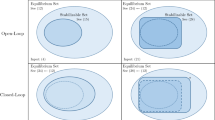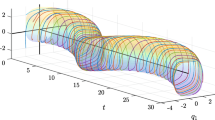Abstract
The damping-induced self-recovery phenomenon refers to the fundamental property of underactuated mechanical systems: if an unactuated cyclic variable is under a viscous damping-like force and the system starts from rest, then the cyclic variable will always move back to its initial condition as the actuated variables come to a stop. The regular momentum conservation phenomenon can be viewed as the limit of the damping-induced self-recovery phenomenon in the sense that the self-recovery phenomenon disappears as the damping goes to zero. This paper generalizes the past result on damping-induced self-recovery for the case of a single unactuated cyclic variable to the case of multiple unactuated cyclic variables. We characterize a class of external forces that induce new conserved quantities, which we call the damping-induced momenta. The damping-induced momenta yield first-order asymptotically stable dynamics for the unactuated cyclic variables under some conditions, thereby inducing the self-recovery phenomenon. It is also shown that the viscous damping-like forces impose bounds on the range of trajectories of the unactuated cyclic variables. Two examples are presented to demonstrate the analytical discoveries: the planar pendulum with gimbal actuators and the three-link planar manipulator on a horizontal plane.





Similar content being viewed by others
References
Chang, D.E., Jeon, S.: Damping-induced self recovery phenomenon in mechanical systems with an unactuated cyclic variable. J. Dyn. Syst. Meas. Control 135(1), 021011 (2013)
Frohlich, C.: Do springboard divers violate angular momentum conservation? Am. J. Phys. 47(7), 583–592 (1979)
Gregg, R.D.: Geometric control and motion planning for three-dimensional bipedal locomotion. Ph.D. dissertation, University of Illinois at Urbana-Champaign (2010)
Kane, T.R., Scher, M.P.: A dynamical explanation of the falling cat phenomenon. Int. J. Solids Struct. 55, 663–670 (1969)
Krishnaprasad, P.S.: Eulerian many-body problems. Contemp. Math. 97, 187–208 (1989)
Marsden, J.E., Ratiu, T.: Introduction to Mechanics and Symmetry: A Basic Exposition of Classical Mechanical Systems. Springer, Berlin (1995)
Marsden, J.E., Montgomery, R., Ratiu, T.S.: Reduction, symmetry, and phases in mechanics. Mem. Am. Math. Soc. 436 (1990)
Montgomery, R.: Gauge theory of the falling cat. Fields Inst. Commun. 1, 193–218 (1993)
Montgomery, R.: A Tour of Subriemannian Geometries, Their Geodesics and Applications. AMS, Providence (2006)
Ruina, A.: Cats, astronauts, trucks, bikes, arrows, and muscle-smarts: stability, translation, and rotation. Talk at Dynamic Walking 2010. http://video.mit.edu/watch/dynamic-walking-2010-andy-ruina-cats-astronauts-trucks-bikes-arrows-and-muscle-smarts-stabil-6010/ (2010)
Spong, M.W.: Partial feedback linearization of underactuated mechanical systems. In: Proc. IEEE Conference on Intelligent Robots and Systems, Munich, Germany, pp. 314–321 (1994)
Author information
Authors and Affiliations
Corresponding author
Additional information
Communicated by A. Bloch.
Rights and permissions
About this article
Cite this article
Chang, D.E., Jeon, S. On the Damping-Induced Self-Recovery Phenomenon in Mechanical Systems with Several Unactuated Cyclic Variables. J Nonlinear Sci 23, 1023–1038 (2013). https://doi.org/10.1007/s00332-013-9177-2
Received:
Accepted:
Published:
Issue Date:
DOI: https://doi.org/10.1007/s00332-013-9177-2




